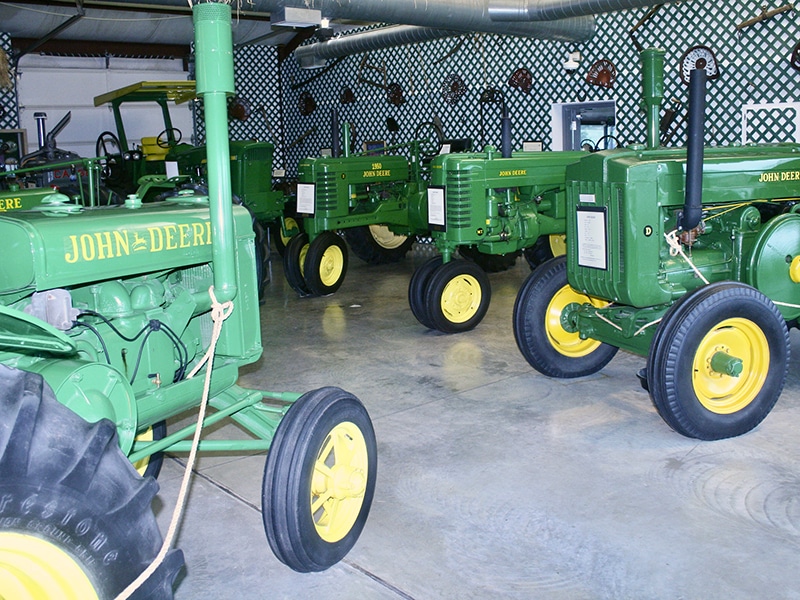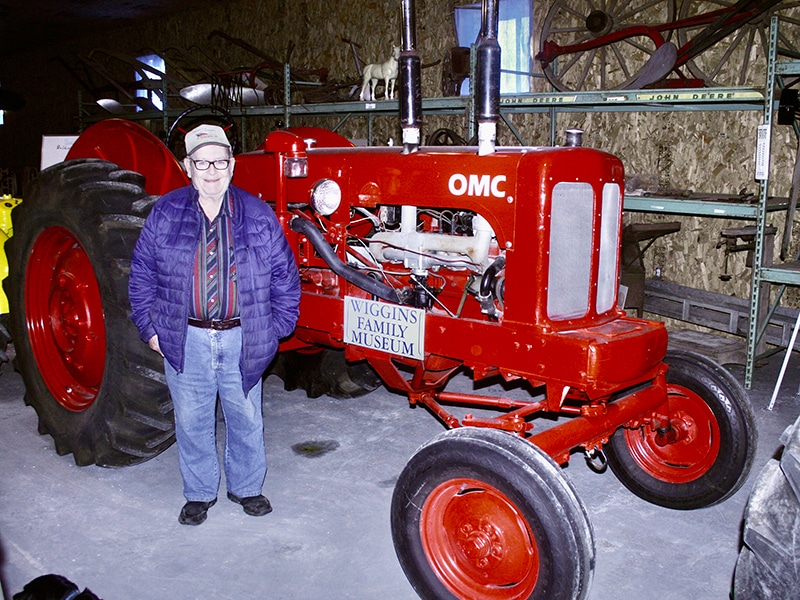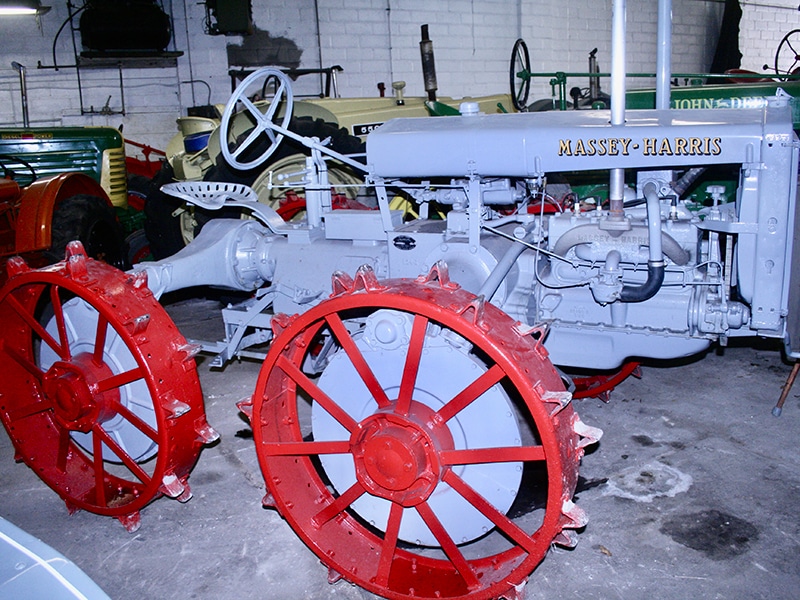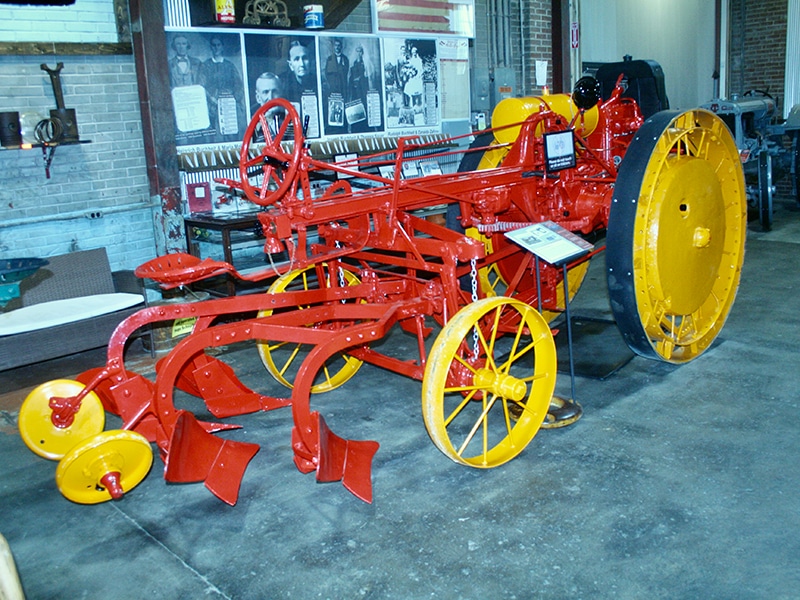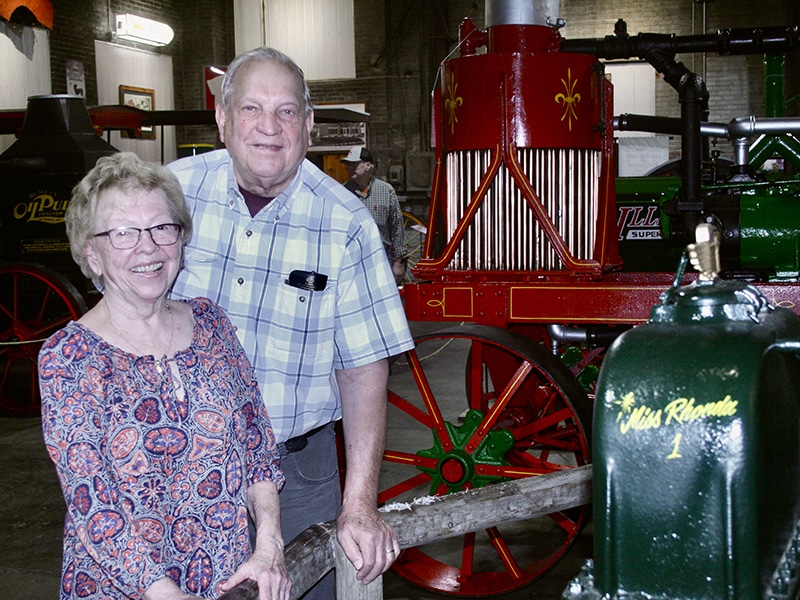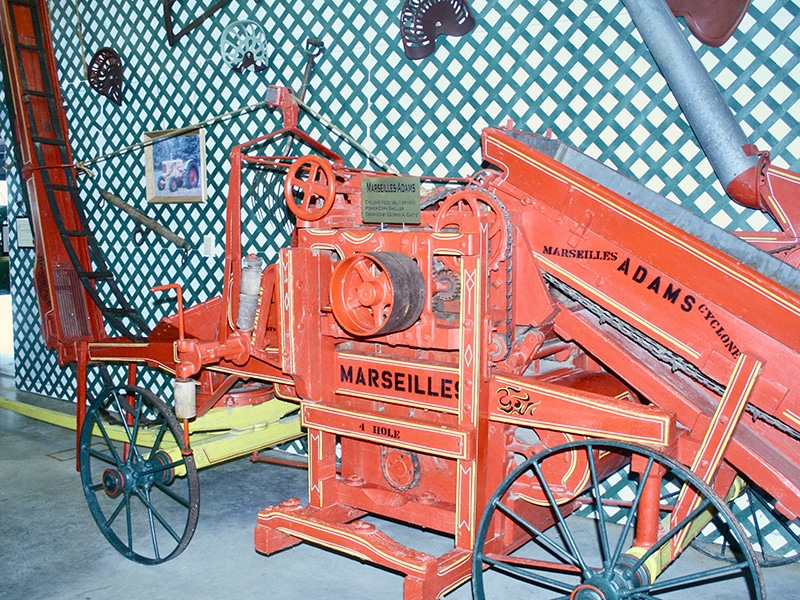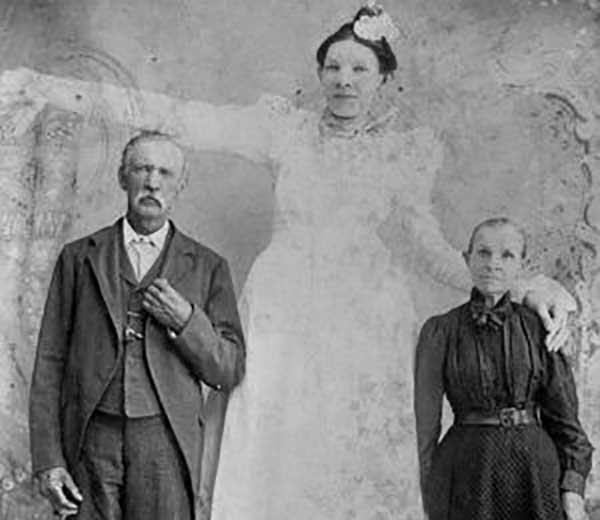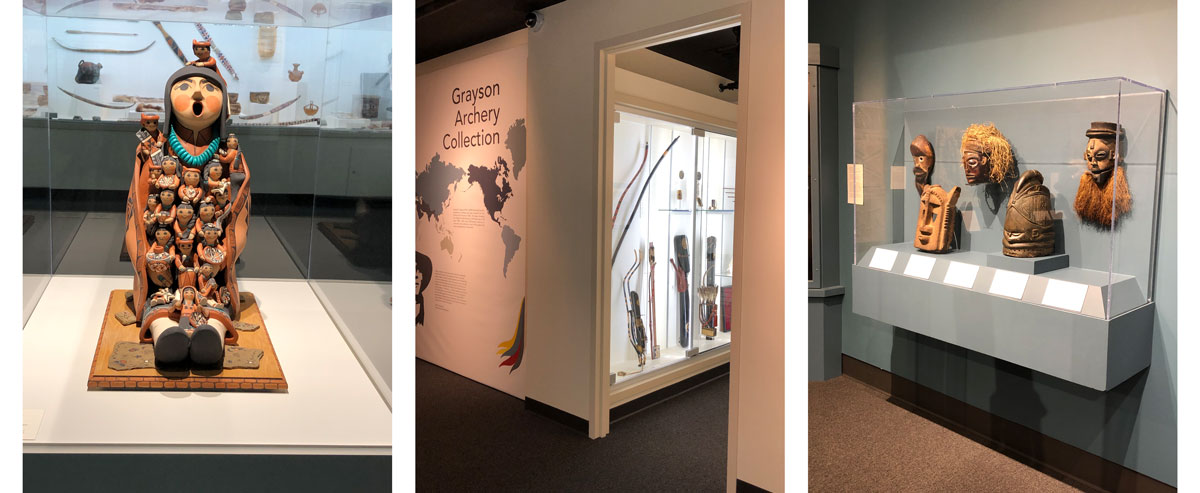
Take a slow ride back to farms of yesteryear
This article originally appeared in the July/August issue of Missouri Life magazine.
With grinding gears, mechanical rumbles, and coarse words from reluctant farmers who weren’t ready to give up their horse-drawn plows, the tractor revolutionized American farming. Three Missouri museums celebrate those sturdy machines and tell the tale of how they evolved into the high-tech behemoths that populate today’s fields.
The American Tractor Museum
At the turn of the 20th century, most fields were still plowed and harvested with horse-pulled implements. Steam engines and, eventually, gasoline engines introduced mechanization to farming. It was an innovation that made crop planting and harvesting easier and allowed farmers to expand their operations.
“There is an evolution of tractors,” says Lori Heberlie, director of the American Tractor Museum in Perryville. “A lot were built in blacksmith shops pre-World War II.” Early tractors weren’t as versatile as later models.
“It was hard to transition from the horse to the mechanical,” Lori says. “Each tractor had a function it needed to serve.”
Kenny Buchheit had been collecting tractors for more than two decades when, in 2020, he opened the American Tractor Museum with more than 60 tractors and farm machines, and he is particularly fond of the early examples.
“The 1930s and pre-1930s models have so much more history,” Kenny says. Lori adds, “We have over 20 tractors that are over a century old. A lot of these are orphan tractors; their companies are no longer in business.”
Informative signs at the American Tractor Museum offer QR codes that visitors can scan with their smartphones to read more details. Some tractors are noted to be one of only a small number made. Many of the exhibits, like the one featuring a cultivator in a small mock field, give visitors a clear vision of what the machine was supposed to do.
“It will make it easier for the kids to see how the equipment was used,” Lori says.
Gaetz Tractor Museum
On the campus of College of the Ozarks in Hollister is the Gaetz Tractor Museum. Thomas Debo, a curator for The Ralph Foster Museum, also on the campus, says the initial collection for the George A. and Sophia L. Gaetz collection came in the 1980s. Until a building was built specifically to display the Gaetz family tractors in the 1990s, the machines were out in the open.
Former College of the Ozarks staffer Joe Robbins helped restore the tractors. Each one was an annual class project. Three-quarters of this museum’s collections belonged to the Gaetzes and were donated to the school by family members when George and Sophia passed. Many are John Deere. In 2005, other people, most with connections to the college, began donating tractors to the museum.
The Gaetz Museum has more than 40 tractors and implements that date back to at least 1919, but two implements had even earlier production years. The collection includes oddities that modern-day tractor owners would find astonishing.
“We got some things out of a parts dealership,” Thomas says. “We have a battery made of wood that came in a cardboard box.”
Three items from the Gaetz collection are on display at the nearby Foster Museum. One of those is a huge steam engine, built circa 1891, with metal tires that made nasty ruts when moved. Thomas says that in 1976, the campus added asphalt roads. The asphalt arrived in Hollister in a railroad tank car, but there was no way to heat it to apply it to the roads. That 1891 steam engine did the job.
Another rare tractor in the Foster Museum is a circa 1918 tractor where the driver sits about eight feet behind the engine, or as Thomas says, “way the heck in back.” This tractor was a problem if the farmer hit a ditch as it could catapult the driver.
ABOVE: The Gaetz Museum features an extensive John Deere collection; among the gems in Larry “Doc” Wiggins’s collection are an OMC and a steel-wheeled Massey-Harris.
Wiggins Family Museum
In northeast Missouri in the town of Memphis, longtime veterinarian Larry “Doc” Wiggins has 350 tractors located in 11 buildings as part of the Wiggins Family Museum.
“I started collecting about 50 years ago,” Larry says. “My boys, David and Mark, wanted pull tractors and had separate tractors. Then I wanted a pull tractor. They still pull, but only with Fords.”
Those first tractors were the start of something big, but even with a collection as impressively large as Larry’s, he can recall the details of every purchase.
“I remember buying each tractor, where it came from, and what it cost,” he says. When it comes to restoration, Larry says his family used to do that but now they hire three separate restorers.
The Wiggins Family Museum is a big attraction when Memphis holds its annual four-day Antique Fair. During that festival, it’s not uncommon to see 20 of Larry’s tractors in a parade. It can be quite an international event because several of Larry’s tractors were made in England. One was made in Argentina.
“A lot of the tractors are donated to us to be restored and put in the museum,” Larry says. “They mean a lot to the families. Now, grandkids can come and see Grandpa’s tractors.” Larry has stopped buying common tractors. “Now I buy the rare and unusual,” he says, adding he’s only missed one Mecum’s tractor auction in Davenport, Iowa, in the last 10 years.
Vintage Variety
At all three tractor museums, the machines vary widely in design complexity and size. Many of the companies that once made tractors and implements shuttered their operations long ago. Several of the brands on display were manufactured and sold in specific regions before popular national brands gained traction everywhere. You’ll find those familiar brands—John Deere, Case, Allis Chalmers, Ford, International—but all the museums have rarer brands, too.
Some of the tractors are one-of-a-kind. These museums are not drab, colorless rooms full of artifacts. Color is everywhere.
There are the green, red, and orange tractors and implements of common manufacturers, but there are also yellow, blue, gray, black, and even two-color models. Expect to see tractors you’ve never seen before.
In the Gaetz Museum, there’s a 1919 Wallis, several Rumelys, and a Hart-Parr. The American Tractor Museum has a 1919 Twin City, a 1927 Greyhound, a 1918 Heider, a 1920 Samson, a 1918 three-wheeled Case, a kerosene -powered Waterloo Boy, and two Oliver 77 tractors used in the Johnny Cash biopic Walk the Line.
The rarest tractor in the Wiggins Family Museum collection is an Oxford Machine Company tractor, but there are also several Lamborghini tractors that were manufactured before that company got into the sports car business. There is also a Thieman built with a conversion kit that made a tractor out of a truck and an Empire made from post-WWII Jeep parts.
“Most of the Empires were shipped to South American and Africa,” Larry Wiggins says. “I found this one in Tunica, Mississippi.”
Kenny Buchheit’s favorite tractor? “The last one I got, when there is something available I can afford.” Since he keeps adding to the collection, his favorites change frequently. “Most of our tractors have to be restored,” Kenny says. “The harder thing is finding parts.”
ABOVE, a 1919 tractor is on display, and Rhonda and Kenny Buchheit welcome guests to the American Tractor Museum; the Gaetz Museum features a pre-1900s Marseilles corn sheller.
Tractor Stories
People coming to the museums to learn about the tractors often relate their own accounts of farm machinery. Lori Heberlie recalls that she found her father’s Oliver 77 hard to shift.
“My dad rigged it to put it in gear, and I raked hay, then I hit a toggle switch to kill the engine.”
When Kenny began collecting tractors, his wife, Rhonda, wasn’t happy with what he brought home.
“It was the awfulest tractor you ever did see,” Rhonda says. “I said if you are going to do this, get ones people would like to see.”
But a 1924 Hart-Parr in the American Tractor Museum is called “Miss Rhonda” for an obvious reason: It is her favorite tractor.
Each piece of equipment in these three museums comes with a story as individual as the men and women who used them to make a living. Even sitting idle, these tractors are cultivating interest from new generations as they explore America’s agricultural history
The American Tractor Museum
Mondays through Fridays, 9 AM to 4 PM, and the first and third Saturdays from 10 AM to 2 PM.
Admission: $10 for adults, $5 for children.
508 N. Main St., Perryville
AmericanTractorMuseum.com
The Gaetz Tractor Museum
Mondays through Saturdays from 9 AM to 5 PM.
Admission is free.
100 Opportunity Ave., Hollister
CofO.edu
The Wiggins Family Museum
Open by appointment only, except for four days the last weekend in August for the Memphis Antique Fair.
The museum is located in various locations throughout Memphis.
Call 660-216-4370 for information and an appointment.
From left, the Gaetz Museum features an extensive John Deere collection; among the gems in Larry “Doc” Wiggins’s collection are an OMC and a steel-wheeled Massey-Harris.
Another rare tractor in the Foster Museum is a circa 1918 tractor where the driver sits about eight feet behind the engine, or as Thomas says, “way the heck in back.”
Related Posts
March 9, 1872
Ella Ewing, the “Missouri Giantess,” was born. She grew to be the world’s tallest woman of her time, reaching 8-feet, 4-inches.
Revitalizing Missouri Downtowns
Here’s how Missourians are working together to revitalize downtowns across the state.
Columbia’s Museums Will Amaze
Boost your cultural IQ and have a great time while doing it at Columbia’s museums.

